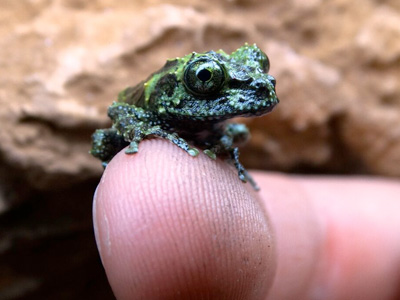Cotswold Wildlife Park welcomes eight rare tiny new arrivals

A tiny success: Cotswold Wildlife Park breeds its first Vietnamese Mossy Frogs.
Meet the ultimate camouflage artist – a brand new species to the Park, the Vietnamese Mossy Frog (Theloderma corticale). In scientific terms, these remarkable amphibians are a relatively recent discovery. Their first recorded sighting was in 1903*. Originating from the steep mountain slopes of Northern Vietnam, due to their remote location, they have been out of reach for scientists and researchers for decades and very little is known about this species in the wild. They are currently protected by the Vietnamese government and listed on the International Union for Conservation of Nature’s Red List of Threatened Species.
Their camouflage has been described as one of the best in the amphibian world. Rough, bumpy skin, combined with complex green and black colouring, makes them almost indistinguishable from a lump of moss or lichen, enabling these tiny Frogs to blend in perfectly with their surroundings and avoid detection by predators. When frightened, they curl into a ball and remain motionless, mimicking death to avoid further harm.
Reptile keepers are thrilled with the first successful breeding of this species at Cotswold Wildlife Park. Eight Mossy Froglets are currently under the watchful eye of the dedicated Reptile team, along with several tadpoles yet to metamorphosise. At this delicate stage of their development, the Froglets remain off-show in the Reptile incubation room. Visitors will be able to see the new species later this year. Updates will be posted on the Park’s Facebook and Twitter pages ( www.facebook.com/cotswoldwildlifepark and @CotsWildTweets ).
Curator of Cotswold Wildlife Park, Jamie Craig, commented: “We treat the rearing of any amphibian to adulthood as a success. The metamorphosing stages can be very tricky and we are delighted to have had repeatable successes with our Mossy Frogs. They are growing well and we hope to create a new display for them in the near future.”
In the wild, this species breeds by larval development in rock cavities containing water and also in tree holes. It takes approximately one year for a tadpole to become a fully developed adult. Researchers have discovered that Mossy Frog tadpoles can exist in water for months without developing, but they metamorphose into Froglets within days when the water dries up.
Frogs have appeared in legend and folklore in many cultures throughout history. Chinese legends involving Frogs date back to 4 B.C. - 57 A.D. Special temples were built specifically for Frogs. In these temples, live Frogs were encouraged to stay with offerings of food and water. When the amphibians wandered away from their appointed homes, they would be brought back to the temple accompanied by drums and music. In ancient Egypt, carvings and religious statues were made in the image of Frogs. Archaeologists have also discovered embalmed Frogs in some Egyptian burial sites.
Explore Gloucestershire
10 March 2016
For further information.
OTHER NEWS
